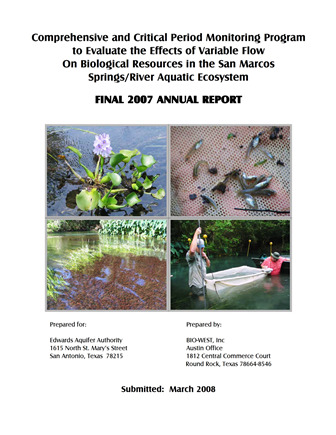Comprehensive and Critical Period Monitoring Program to Evaluate the Effects of Variable Flow on Biological Resources in the San Marcos Springs/River Aquatic Ecosystem Final 2007 Annual Report

| Summary |
|
The purpose of this report is to document the results of all aquatic ecosystem monitoring conducted in 2007 at San Marcos Springs located in San Marcos, Texas. The monitoring and report preparation was performed by BIO-WEST, Inc. Pflugerville, Texas. [Excerpted from Executive Summary] Overall, aquatic vegetation in the San Marcos River decreased in 2006 because of direct and indirect effects of the low flows. Increased flows in 2007 appeared to stimulate growth and encourage colonization of areas that were bare as a result of mechanical disturbance in 2006… Texas wild-rice (Zizania texana) was the most vulnerable plant to mechanical disturbance in 2006 decreasing nearly 75% in this reach after people pulled out many of the leaves. Fortunately, many of the root-wads remained, and in 2007 these roots enabled the plants to recover relatively quickly in the higher flows. Texas wild-rice plants in the eastern arm of the reach increased their surface area several times, and several new plants were also found. Downstream, plants that had been disturbed in 2006 began to grow back together, and seeds could be seen by summer. Educational signs placed along the banks in this reach were a great contribution to educating the public about wild-rice and other endangered organisms in the system…. The City Park Reach exhibited a similar resurgence in vegetation area…. The suitability of the various vegetation types (as measured by fountain darter density) is considerably lower in the San Marcos River when compared with the Comal River. As expected, fountain darter densities were highest in Cabomba and surprisingly, Hydrilla. It is unclear why Hydrilla was a preferred habitat in 2007, but further monitoring may provide an answer. Similar to previous years, the smallest darters were captured in spring indicating a spring reproductive peak…. Exotic species continue to inhabit the San Marcos River, but did not appear to have any noticeable impacts during 2007. San Marcos salamanders (Eurycea nana) continued to be common in Spring Lake where large areas are covered in filamentous algae. Salamander density below Spring Lake Dam was near the highest observed since the inception of this study…. Following an extremely low flow year (2006) in the San Marcos River, the biological communities responded well in 2007. Texas wild-rice re-colonized several areas where it had been previously stripped, and estimates of fountain darters continued to be high. |
Search for Documents
Advance Search
Explore EAA's Scientific Reports
- All Reports
- Hydrology and Hydrogeology
- History
- Groundwater Recharge, Recharge Zone
- Groundwater Movement
- Geomorphology and Caves
- Weather Modification
- Geology
- Water Use and Conservation
- Geochemistry
- Water Resources Planning and Management
- Floods and Drought
- Water Quality
- Climatology
- Surface Water / Groundwater Relationship
- Biology
- Springs, Groundwater Discharge
- Archaeology
- RZ Protection
- Aquifer Levels
- Remote Sensing
- Precipitation
- Overview Studies
- Modeling
